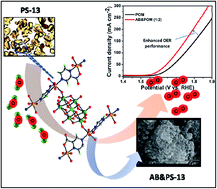Improved OER performance of an Anderson-supported cobalt coordination polymer by assembling with acetylene black†
Abstract
Anderson–Evans type polyoxometalates (POMs) are regarded as excellent nanosized inorganic building blocks for the construction of multifunctional hybrid materials because of their ease of covalent modification. A novel Anderson-based coordination polymer, [{Co(2-pzc)(H2O)2}2{H7AlMo6O24}]·10(H2O)·2.5(CH3OH) (PS-13), has been synthesized and explored for electrocatalytic oxygen evolution. The integration with a co-catalyst, acetylene black (AB), results in AB&PS-13 (1 : 2), a composite material with substantial OER catalytic properties when compared to other known POM-based materials. It shows electrochemical oxygen evolution, with an overpotential of 330 mV at 10 mA cm−2, in alkaline aqueous solution (1 M KOH) with a stability of up to 40 h. As far as we are aware, this is the first report on electrocatalytic OER performance by any Anderson cluster based solid. Its integration with AB enhances the OER performance by approx. 11%. This research will offer a new perspective on the construction of efficient and resilient POM-based catalysts in the OER.



 Please wait while we load your content...
Please wait while we load your content...